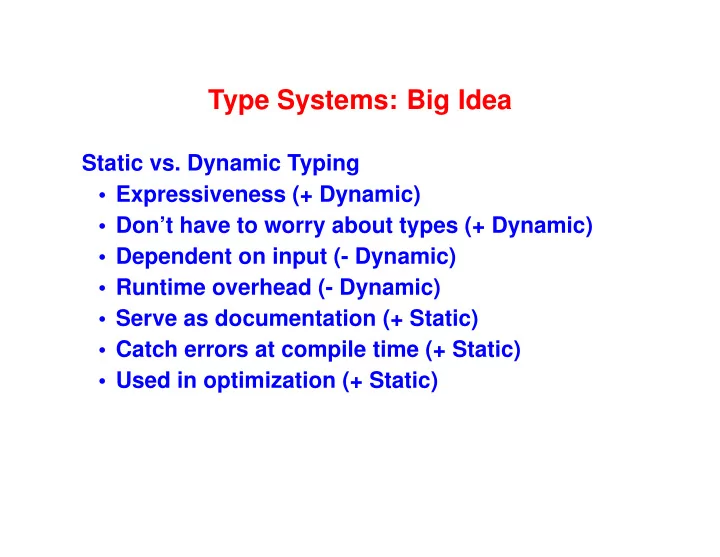

Type Systems: Big Idea Static vs. Dynamic Typing • Expressiveness (+ Dynamic) • Don’t have to worry about types (+ Dynamic) • Dependent on input (- Dynamic) • Runtime overhead (- Dynamic) • Serve as documentation (+ Static) • Catch errors at compile time (+ Static) • Used in optimization (+ Static)
Type Systems: Big Idea • Undecideability forces tradeoff: – Dynamic or – Approximate or – Non-terminating • Example: array bounds checking – Occasional negative consequences: e.g., Heartbleed
Type Systems: Mechanics • Monomorphic and Polymorphic Types • Types, Type Constructors, Quantified Types ( 8 �:� ) • Kinds ( � ) classify types: – well-formed, – types (*), – type constructors: � ) � • Type Environments: type identifiers ! kinds • Typing Rules – Introduction and Elimination forms • Type Checking • Induction and Recursion
Hindley-Milner Type Inference: Big Idea • Inferred vs Declared Types – Advantages of Inference: write fewer types, infer more general types. – Advantages of Declarations: better documentations, more general type system. • Canonical example of static analysis: – Proving properties of programs based only on text of program. – Useful for compilers and security analysis.
Hindley-Milner Type Inference: Mechanics • Use fresh type variables to represent unknown types • Generate constraints that collect clues • Solve constraints just before introducing quantifiers • Compromises to preserve decideability: – Only generalize lets and top-level declarations – Polymorphic functions aren’t first-class
Module Systems a la SML: Big Ideas • “Programming-in-the-large” • Separate implementation from interface • Enforced modularity – Swap implementations without breaking client code
Module Systems a la SML: Mechanics • Signatures describe interfaces – types, values, exceptions, substructures – include to extend • Structures provide implementations • Signature ascription hides structure contents (Heap : > HEAP) • Functors – Functions over structures – Executed at compile time
Object-Oriented Programming: Big Ideas • “Programming-in-the-medium” • Advantages and Disadvantages – Enables code reuse – Easy to add new kinds of objects – Hard to add new operations – Algorithms smeared across many classes – Hard to know what code is executing • Good match for GUI programming • Smalltalk mantra: Everything is an Object – Can redefine basic operations
Object-Oriented Programming: Mechanics • Classes and objects • Computation via sending messages • Double-dispatch • Inheritance for implementation reuse • Subtyping (“duck typing”) for client code reuse • Subtyping is not Inheritance • self and super • Blocks to code anonymous functions & continuations
Lambda Calculus: Big Ideas • Three forms: e ::= x � x : e j e 1 e 2 j • Church-Turing Thesis: – All computable functions expressable in lambda calculus – booleans , pairs , lists , naturals , recursion , . . .
Lambda Calculus: Mechanics • Bound vs. Free variables • � -conversion: Names of bound variables don’t matter. • � -reduction: Models computation. • Capture-avoiding substitution (Why important?) • Recursion via fixed points • Y combinator calculates fixed points: – Y � f : ( � x : f ( x x ))( � x : f ( x x )) =
Substitution Example Consider let x = 10 in (\y.\x.x + y) x 3 Naive substitution (wrong!): let x = 10 in (\x.x + x) 3 Capture-avoiding substitution (right!): let x = 10 in (\z.z + x) 3 Naive version evaluates to 6, correct version to 13.
Programming Experience • Recursion and higher-order functions are now second-nature to you. – You’ll miss pattern matching and algebraic data types in any language you use that doesn’t have them! • C for impcore (imperative language) • Scheme (dynamically typed functional language) • ML (statically typed functional language) • uSmalltalk (dynamically typed OO language)
Built substantial pieces of code • SAT solver using continuations • Type checker (ML pattern matching!) • Type inference system (using constraints, reading typing rules) • Game solver (SML module system) • BigNums (Power of OO abstractions; resulting challenges)
Where might you go from here?
Haskell • At the research frontier: Still evolving. • Lazy : – Expressions only evaluated when needed. – Conflict with side-effects. – Solution: Monads (computation abstraction) • Type Classes: – Ad hoc polymorphism (aka, overloading) – ML: Hard-wire certain operations (+, *) – Haskell: User programmable.
Prolog • Based on logic. • Performs proof search over inference rules. • Can leave “blanks” and ask the system to figure out what they must be.
Ruby • If you liked smalltalk.
Additional Courses • Compilers • Special Topics: – Domain-specific Languages – Probabilisitic Programming Languages – Advanced Functional Programming
Big-picture questions?
Studying for the Exam • Exam will be like midterm • Expect to write some code (SML, uSmalltalk) • Review homework assignments • Review recitation materials • Make sure you understand Big Ideas/Tradeoffs
Other Questions?
Course feedback In future courses • What should we keep the same? • How can we improve?
Congratulations! • You have learned an amazing amount. • You have really impressed me. • Good luck on the exam! **Thank you!**
Recommend
More recommend